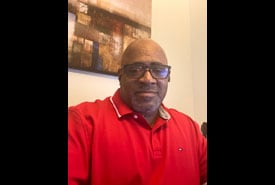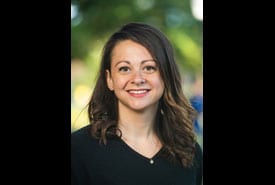At a glance
Meet flu fighters Bernard Macklin and Sarah Gordon. Macklin is a flu vaccination outreach coordinator, and Gordon is health communications lead for Racial and Ethnic Approaches to Community Health (REACH) Program at the Community Alliance for Research & Engagement (CARE). With over 20 years’ experience in his field, Macklin has completed an admirable amount of work as part of the CARE Flu Supplement program, where his work focuses on getting people vaccinated. Gordon’s outreach work focuses on creating culturally relevant messages with resonance to the community and having continued message feedback from community members.

Bernard Macklin, B.A.
Meet Bernard Macklin, a flu vaccination outreach coordinator for Community Alliance for Research & Engagement (CARE) from Southern Connecticut State University with over 20 years of experience in his field. Macklin has completed an admirable amount of work as part of the CARE Flu Supplement program, where his work focuses on getting people vaccinated. Through outreach efforts he educates people about the benefits of getting a flu vaccine. He believes successful flu vaccine communication must provide only the facts, be truthful and honest about the flu, and build quality relationships in communities. After losing his brother to an infectious disease, he has a different view of the importance of his work. His brother's death motivates him to fight harder to help people be healthier and protected from disease. For Macklin, the highlight of his work is being able to see people getting vaccinated in his community and sharing educational information for all to see.

Sarah Gordon, M.A.
Meet Sarah Gordon, a health communications lead for Racial and Ethnic Approaches to Community Health (REACH) Program at the Community Alliance for Research & Engagement (CARE). The key elements of her work are message development, message testing, formative research, market research, media relations, social media campaign creation, and web and graphic design for flu vaccination communication efforts. Her outreach work focuses on creating culturally relevant messages with resonance to the community and having continued message feedback from community members. Her motivation behind her work is to combat the large amount of misinformation that is available about influenza and flu vaccination and to ensure that only correct information is disseminated, while sharing New Haven community members' real-life experiences. She wants people who are hesitant about getting the flu vaccine to know that it is not just about an individual but also about protecting the community as a whole.

What is the goal of the program?
SARAH
The goal of our program is to employ a community-engaged approach to inform and educate residents about flu vaccines and to increase access to flu vaccines with a focus on Black and Brown communities in New Haven.
How does the program seek to address flu and health disparities?
SARAH
Our program focuses on increasing flu vaccination rates among Black and Brown communities, who bear a greater burden of flu. Strategies include using trusted messengers to educate the community about vaccination and to dispel myths and misinformation, while increasing access to the vaccine through mobile clinics.
Why is it important to fight flu in your program’s community?
SARAH
Communities of color are at a higher risk of hospitalization due to flu illness. Also, many New Haven residents in the Black and Brown communities have chronic diseases such as asthma, diabetes, obesity and heart disease that put them at higher risk for serious complications from flu illness–therefore, increasing the importance of a flu vaccine.
What successes have been realized through the program?
SARAH
Through our communications and outreach efforts, we have reached approximately 3,350 residents. Additionally, we have trained a total of 33 community members to be influential messengers and have held six different flu clinics in November and December of this year.
